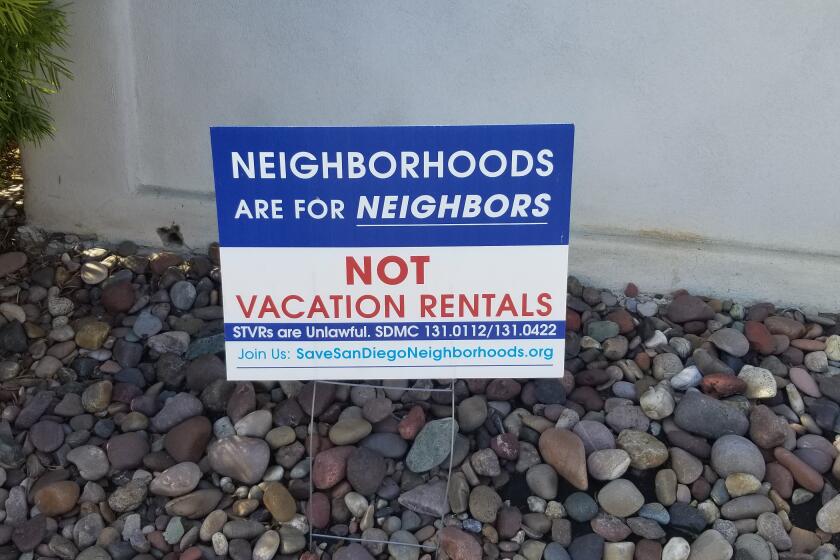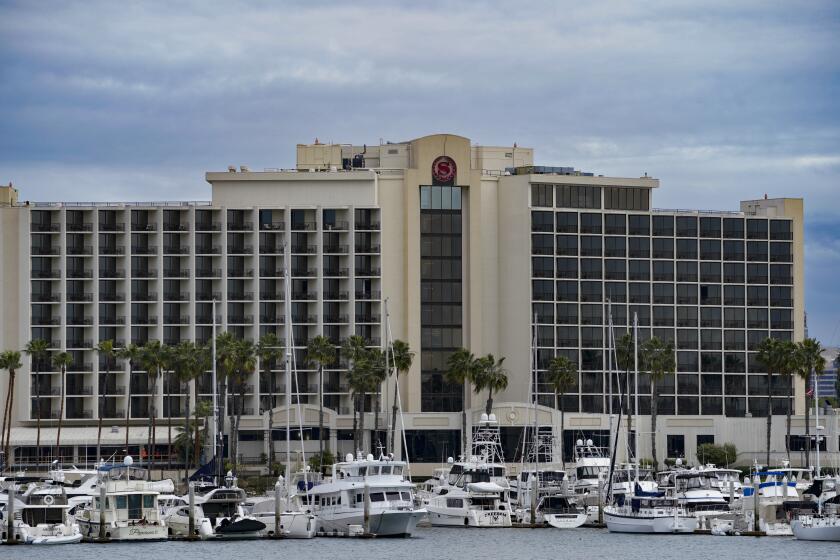Study endorses bayfront center expansion
An eagerly awaited report analyzing the financial return on an expanded San Diego convention center reaffirms what its backers have long advocated: It needs to be on the waterfront.
The $90,000 study, though, isn’t likely to quiet the debate over where an expansion should go – if it can even get built – or how to pay for it.
The analysis, which will be formally released today, finds that additional convention space, no matter where it goes, will deliver an economic return. But it’s unequivocal in its conclusion that an enlarged center on the current bayfront site easily trumps a campus-like facility several blocks to the northeast when it comes to the dividends the city will reap.
San Diego Mayor Kevin Faulconer said the report, prepared by Convention Sports & Leisure International, is persuasive enough that he plans to begin work anew on a bayfront expansion project, with a goal of putting on the ballot a hotel tax increase to finance it as early as next year. Such a measure would require a two-thirds majority approval by voters.
“The study clearly shows that having a contiguous convention center expansion is a huge economic benefit, has the most immediate impact and provides the best return on investment,” said Faulconer, who had been awaiting the report’s outcome before deciding how to proceed. “It’s always been clear visitors have to pay for an expanded convention center. There’s strong community support for expanding our tourism economy because that paves our roads and keeps our libraries open so a strong, expanded convention center means more dollars we can spend on infrastructure in San Diego neighborhoods.”
He acknowledges that the timing, though, will depend on the outcome of still pending litigation challenging the California Coastal Commission’s approval of an earlier expansion proposal that fell through last year after a judge ruled that a hotelier-approved room tax to finance the bulk of the $520 million project was unlawful. The mayor’s office believes that the current litigation may well be resolved within the next six months.
Attorney Cory Briggs, who prevailed in the hotel tax case and is pursuing the Coastal Commission litigation, promises continued legal challenges as long as the city attempts to develop the waterfront with added convention facilities.
“Any effort to put a convention center expansion on the public waterfront will be met with every conceivable lawful challenge,” said Briggs, who predicts his current lawsuits could take as long as five years to resolve, assuming appeals are made all the way to the California Supreme Court. “The waterfront, by law, is supposed to be used for public, water-dependent purposes and convention centers are not open to the public and they’re not water dependent. And the only way to pay for it is to impose a tax, and there’s no way they can get a two-thirds vote in this town.”
While tourism leaders and hoteliers have long pushed for a contiguous expansion of the center, the Convention Center Corp. thought it was worthwhile to commission a study to finally settle the question of whether there is a willingness among conventioneers to consider holding their events in an off-site, campus-like facility tied to a large convention hotel.
Such an alternative has been advocated by JMI Realty, which owns nearby land where it has considered building a 1,600-room hotel. Such a hotel, the company has said, would complement development of a stand-alone convention facility on what is known as Tailgate Park, a publicly owned parking lot generally located east of 12th Street between K Street and Imperial Avenue, several blocks from the convention center.
The study found that such an expansion would in fact bring more convention business to San Diego, yielding nearly $61.2 million more in spending by convention goers on hotels, eating out and other such expenses, but a waterfront expansion would deliver more than 2.5 times that.
More telling is the consultant’s calculations on return on investment. Taking into account an estimated $549 million cost for a waterfront expansion, it would take 3-1/2 years before the city would effectively make back that money by way of revenues generated by additional convention attendees. By comparison, it would take roughly seven years under an off-site location scenario, based on an estimated $428 million construction cost.
The analysis, which relied heavily on surveys and interviews with event planners representing meetings of all sizes, was based on adding more than 200,000 square feet of exhibit space to the center’s existing 525,000 square feet of floor space. It also comes at a time when many other cities like Los Angeles, Anaheim and San Francisco are either considering enlarging their centers or are already in the midst of doing so.
While a larger center on San Diego’s bayfront would attract just a few more events each year than an off-site location, it’s the nature and size of those additional conventions that tilt the economic balance in favor of a contiguous expansion, said the study’s author, John Kaatz.
“It comes down to being able to retain and attract the largest events,” Kaatz said. “Any one of those events is over $30 million in direct spending. The large meeting planners aren’t excited about the campus option, and you may lose one or two of those. So if you’re a Microsoft or full-building user like that, you’re going to lose that really big event under the campus option. You can replace that with a smaller corporate event, but then you’re starting to trade very large, high-impact events for smaller events with smaller, more modest spending.”
He estimates that with the contiguous option, the city would retain and/or capture two very large events each year that would otherwise be lost with the off-site location. Both options would allow more conventions to take place at the same time, but there would be less flexibility with the off-site location, Kaatz said.
Local convention center officials have long argued that San Diego, while it remains a top destination for meeting planners, is in danger of losing its largest, most lucrative gatherings because of their need for more space. Most notable is Comic-Con, which long ago outgrew the center but recently committed to stay here through 2018, recognizing that there would not necessarily be an expanded center by then.
In focus groups held in Washington, D.C., and Chicago, some meeting planners stressed the importance of having water views as a part of their events, noting that it is part of the San Diego brand, although some planners overseeing mid-sized events said that a campus location would be fine for their associations.
While JMI had been strongly considering developing a hotel on its nearby Ballpark Village property, the mayor’s interest now in pursuing a waterfront expansion could steer the company toward plans it had also been considering to develop the land for housing. JMI, former Padres owner John Moore's development company, was responsible for building Petco Park.
“Right now there are buyers to finance residential development," said Steve Peace, of JMI, which has partnered with Lennar Homes on the Ballpark Village site. "We've had that property for a decade, which is a long time to hold a piece of property.”
The report, however, does suggest that the city additionally consider a possible public-private partnership on a privately developed hotel that would include substantial meeting space in that area.
Faulconer said he intends to initiate discussions with JMI to see what possibilities lie ahead. Peace had not yet seen a copy of the expansion study.
“It’s pretty clear a contiguous expansion is the preferred choice, but we will look to JMI for their plans for a hotel to serve a different niche,” he said. “The report said that could be an additional option so I want to bring all the stakeholders together.”
Get U-T Business in your inbox on Mondays
Get ready for your week with the week’s top business stories from San Diego and California, in your inbox Monday mornings.
You may occasionally receive promotional content from the San Diego Union-Tribune.













